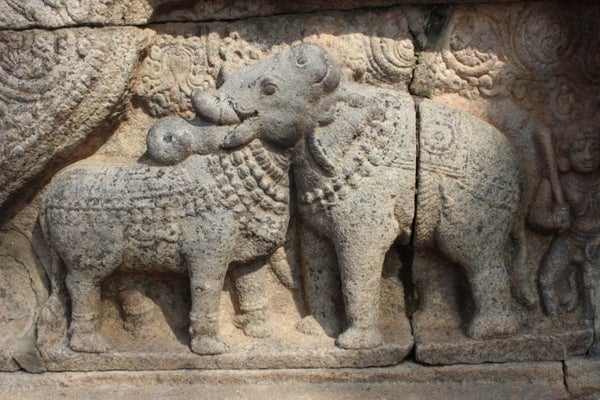This article was published in Scientific American’s former blog network and reflects the views of the author, not necessarily those of Scientific American
The Airavatesvara Temple in India contains an exquisite bas-relief—sculpted at least 850 years ago and remarkably well preserved—which has captured the attention of both art historians and vision scientists. What makes this piece of art remarkable is neither the subject depicted, nor its delicate details, but the fact that it contains one of the oldest examples of illusions in art. The creature it represents can be seen as either an elephant or a bull, an ancient example of ambiguous brain teasers such as the duck/rabbit, or the old/young lady illusions.
.gif)
The Airavatesvara Temple bas-relief depicts the bodies of two different animals, sharing a single head. When the body and legs of the animal on the right are removed, the creature left behind looks like a bull facing right. But if one eliminates the body and legs of the bull instead, what remains is an elephant facing left. Credit: Animation by Daniel Cortes, Martinez-Conde and Macknik Laboratories
.JPG?w=900)
The equivocal bas-reliefs in Airavatesvara and Mahabalipuram could be early examples of popular ambiguous designs, such as the duck-and-rabbit, and the old-lady-and-young-lady illusions. Credit: William Ely Hill (1887–1962) Wikimedia(left); Fliegende Blätter 1892 Wikimedia(right)
On supporting science journalism
If you're enjoying this article, consider supporting our award-winning journalism by subscribing. By purchasing a subscription you are helping to ensure the future of impactful stories about the discoveries and ideas shaping our world today.
Also in India, the city of Mahabalipuram is home to a possibly even older ambiguous illusion, sculpted on a pillar some 1300 years ago. At first sight, the depiction appears to be of a cow and her calf, but if one blocks the center of the carving, it becomes a portrayal of an adult and a baby elephant.
Ancient artistic illusions provide us with vivid examples, not only of human creativity and craftsmanship, but of our early aptitude for flexible thinking—such as our ability to switch our perspective back-and-forth between alternate viewpoints. It follows that fascination with illusions could be old as humankind.
PREHISTORIC DUPLICITY
Through human history, artists have devised many clever ways to make audiences perceive flat frescos as having depth, or mere brushstrokes on a canvas as a bowl of fresh fruit. The ruse is as old as human imagination. There is evidence that the paleolithic artists that decorated the walls and roof of the Cave of Altamira with horses and bison, some 20,000 years ago, used the natural bulges of the rock to add illusory volume and depth to their depictions.
The deception is perhaps even greater in the case of paleolithic art studied by prehistorian Duncan Caldwell in the cave of Font-de-Gaume and other sites in France. In a paper presented at an international conference in rock art in 2010, Caldwell displayed multiple examples of cave drawings and engravings that could be interpreted as portrayals of either woolly mammoths or bison. Caldwell posited that the physical similarities between the two animal shapes made them ideal candidates for prehistoric artists to superimpose their respective images in the same depiction.
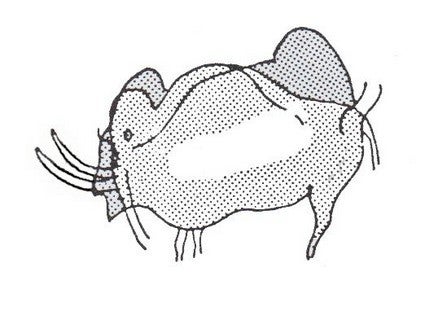
The contours of a bison and a mammoth overlap in this sketch of prehistoric art, copied from the walls of the Font-de-Gaume cave by the cave art researcher Henri Breuil. Credit: Duncan Caldwell
* Caldwell, Duncan. 2012. The Identification of the First Palaeolithic Animal Sculpture in the Ile-de-France: The Ségognole 3 Bison and its Ramifications. In: Pleistocene Art of the World, edited by Jean Clottes. N° spécial de Préhistoire, Art et Sociétés, Bulletin de la Société Préhistorique Ariège-Pyrénées, LXV-LXVI, 2010-2011. pp. 74-75 and CD pp. 419-461. ISBN 987-2-9531148-3-6
** after Daubisse et al.1994: 12.
Reference: DAUBISSE P., VIDAL P., VOUVÉ J., BRUNET J. 1994. — La Grotte de Font-de-Gaume. Périgueux : Pierre Fanlac Éditeur. p. 12.
THE EARLIEST WRITINGS ON ILLUSION
Whereas we do not have access to the inner thoughts or motivations of paleolithic artists—making contemporary interpretations of their artwork unavoidably inconclusive—recorded history provides us with definite proof that people have noticed, and been intrigued, by illusions for thousands of years. The ancient Greek philosopher Aristotle (384-322 BC) wrote the first known descriptions of perceptual illusory in his Parva Naturalia (short treatises on nature). Aristotle’s observations included phenomena such as pareidolia (our predisposition to see faces in meaningless visual patterns), afterimages, and various kinds of adaptation illusions, such as the motion aftereffect (also known as the waterfall illusion). He also described the phenomenon that we know today as the “Aristotle Illusion,” where if you touch a small round object, like a marble, between the tips of two crossed fingers, if feels like you are touching two objects instead.
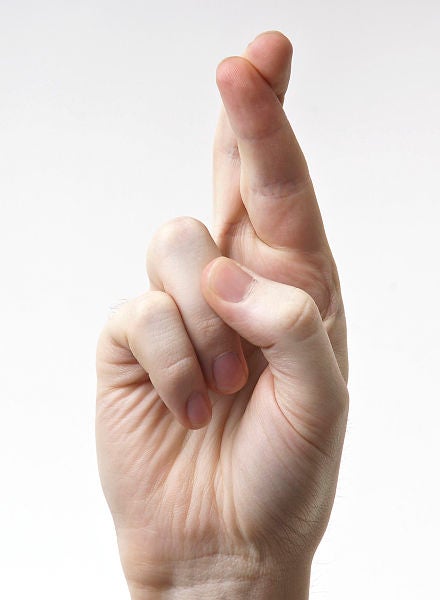
A small marble placed between the two crossed fingertips will feel like two marbles. Or, if you touch the tip of your nose, it will feel as if you have two noses instead of one. Credit: Evan-Amos Wikimedia (CC BY-SA 3.0)
DEUS EX MACHINA
Heron of Alexandria, a Greek-Egyptian inventor (10 CE – 70 AD), may have the first to devise a practical use for illusions. One of his most successful inventions, described in his books Pneumatica and Automata, was an automatic way to open doors, which he implemented in sacred temples to create the fantasy of divine intervention. The deception was possible due to Heron’s aeolipile, a predecessor to the steam engine. The aeolipile’s workings were secret to all, except the priests hosting the ceremonies. The temple doors would appear to open in response to the priest’s commands, by the grace of the gods.
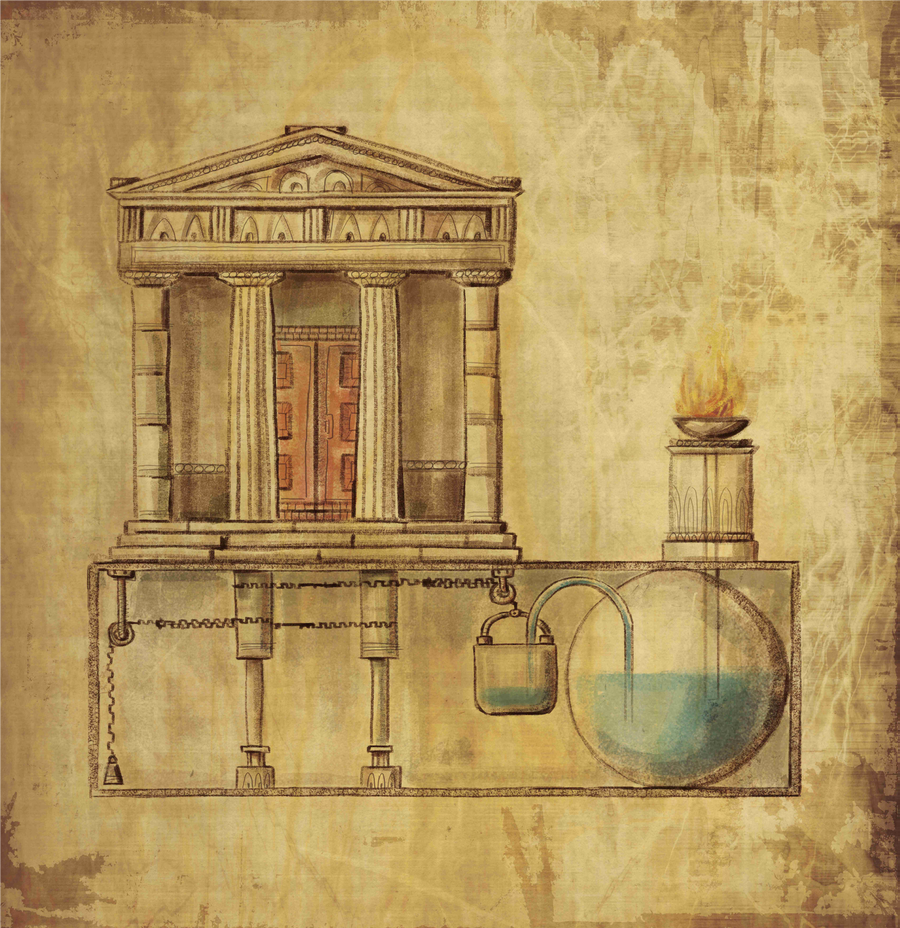
The aeolipile, which controlled the opening of Heron’s temple doors, was based on a water-filled vessel with two connected pipes. When the water boiled, the steam traveled down the tubes and activated a rope mechanism that pulled the doors open. Illustration by Victor Escandell for the Fundación “la Caixa” museum exhibit “Abracadabra, Ilusionismo y Ciencia”. Credit: Victor Escandell
ILLUSION OR ENGINEERING?
Columns in Greek Doric temples tend to bulge slightly in the middle, an architectonic feature known as entasis. Historians have suggested that the purpose of the subtle convexity is to compensate for the illusory slimming that would otherwise occur with perfectly vertical columns. The reasoning goes that actual rectilinear columns would look concave instead, as if they had a ‘waist,’ and so ancient Greek architects rounded them a bit in the middle to compensate for the misperception and make them look straight. It’s a credible explanation (we certainly didn’t question it in high school history class), but alas, there is little scientific basis for it. In a series of experiments published in 2007, the vision scientist Peter Thompson and his colleagues at the University of York in the UK, discovered that the illusion that entasis supposedly counteracts is not there is the first place. Instead, it appears that one likely reason for entasis was the reinforcement of the columns: a column with entasis is more structurally sound, and provides a greater strength-to-weight ratio, than a non-bulging column.
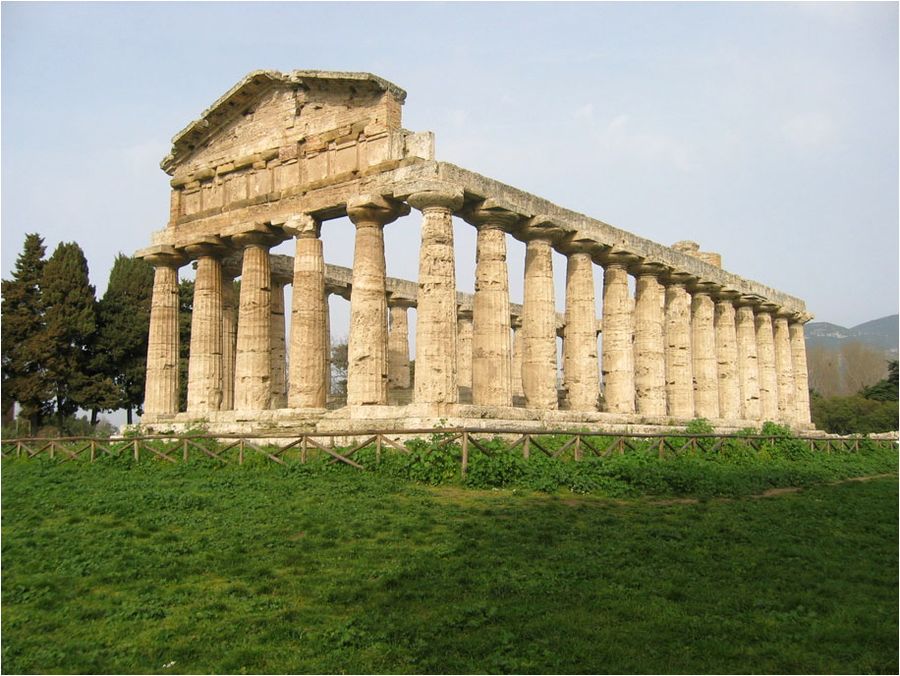
The Greek Temple of Athena (500 B.C.) in Paestum, Italy, has 34 outer columns, all of which exhibit entasis. Credit: Peter Thompson
MORE TO EXPLORE
World’s Oldest Optical Illusion Found? https://blog.nationalgeographic.org/2010/12/22/worlds-oldest-optical-illusion-found/
Ancient Magic: The Illusions Created in Temples by Amazing Inventions https://www.theepochtimes.com/ancient-magic-the-illusions-created-in-temples-by-amazing-inventions_1123060.html
Parva Naturalia. Aristotle, Ross WD (Ed), 2001. Oxford: Clarendon Press.
On the ancient history of the direction of the motion aftereffect. Verstraten FA, 1996. Perception 25(10):1177-87.
The origins of entasis: illusion, aesthetics or engineering? Thompson P, Papadopoulou G, Vassiliou E, 2007. Spat Vis. 20(6):531-43.
